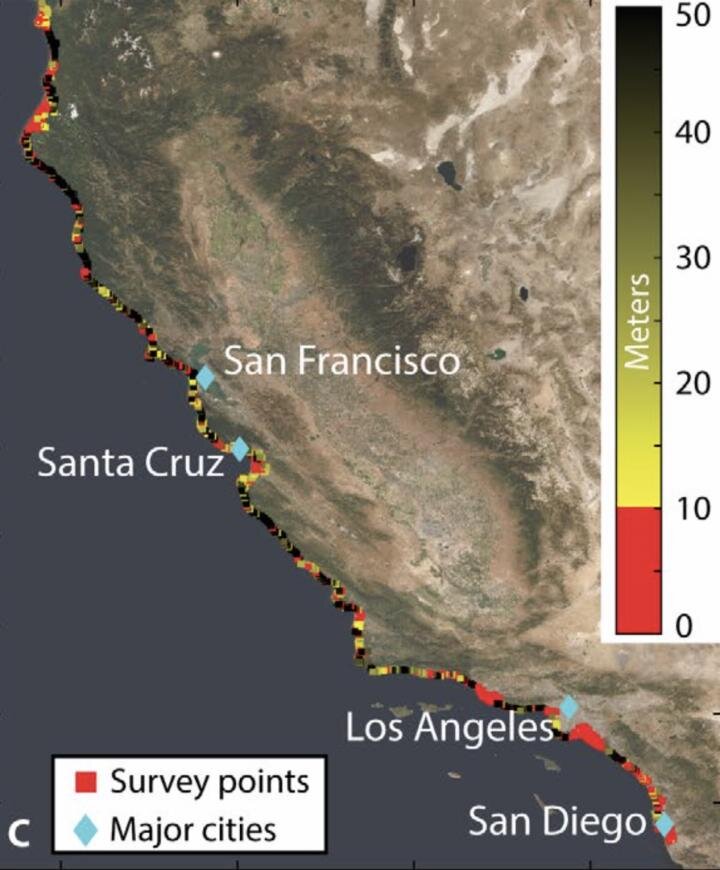

Coastal elevation in California. Coastal zones, defined as those with elevations of less than 10 m, are shown in red. The coastal segments with elevations greater than 10 m are colored by a yellow gradient. Credit: USGS NED.
Most of the world’s population lives in lowlands near the sea, some of which are expected to submerge in the late 21st century due to rising sea levels.
The most relevant quantity for assessing the impacts of sea level change on these communities is the relative rise in sea level, the change in elevation between the height of the Earth’s surface and the height of the sea surface. For an observer standing on shore, the relative rise in sea level is the net change in sea level, which also includes the rise and fall of the land below the observer’s feet.
Now, using accurate measurements from state-of-the-art satellite-based interferometric synthetic aperture radar (InSAR) that can detect the rise and fall of the Earth’s surface with millimeter precision, a research team at Arizona State University has tracked by first time The vertical earth movement of the entire California coast.
They have identified local hot spots on the sinking coast, in the cities of San Diego, Los Angeles, Santa Cruz and San Francisco, with a combined population of 4 to 8 million people exposed to rapid land subsidence, which will suffer a major flood. risk during the decades preceding the expected rise in sea level.
“We have entered a new era of coastal mapping with more than 1,000 times more detail and resolution than ever before,” said Manoochehr Shirzaei, who is the principal investigator for the NASA-funded project. “The unprecedented detail and sub-millimeter precision resolved in our vertical earthmoving dataset can transform our understanding of natural and anthropogenic changes at relative sea level and associated hazards.”
The results were published in this week’s issue of Scientific advances.
The research team included graduate student and lead author Em Blackwell, and faculty Manoochehr Shirzaei, Chandrakanta Ojha, and Susanna Werth, all from ASU’s School of Earth and Space Exploration (Werth has a double appointment at the School of Geography and Urban Planning).
Em Blackwell had a keen interest in geology, and when Blackwell started graduate school, InSAR applications attracted them to pursue this project. InSAR uses radar to measure the change in the distance between the satellite and the ground surface, producing highly accurate deformation maps of the Earth’s surface at a resolution of 10m over a 100km spatial extent.
The subsidence of the earth can occur due to natural and anthropogenic processes or a combination of them. Natural processes include tectonics, glacial isostatic adjustment, sediment loading, and soil compaction. Anthropogenic causes include groundwater extraction and oil and gas production.
As of 2005, approximately 40 million people were exposed to 1 in 100 years of coastal flood risk, and by 2070 this number will increase more than threefold. The value of property exposed to floods will increase to approximately 9% of projected global Gross Domestic Product, with the United States, Japan and the Netherlands being the countries with the highest exposure. These exposure estimates are often based only on projections of global mean sea level rise and do not take into account the vertical movement of the earth.
The study measured the entire 1,350-kilometer-long California coast from 2007-2018, compiling thousands of satellite images over time, used to make a vertical earthmoving map with 35 million pixels at a resolution of ~ 80m, comprising a wide range of Coastal Elevation and subsidence rates. Policy makers in coastal communities and the general public can freely download the data (link in supplementary data).
The four most affected metropolitan areas in these areas include San Francisco, Monterey Bay, Los Angeles, and San Diego.
“The vast majority of the San Francisco Bay Perimeter is sinking with rates reaching 5.9mm / yr,” said Blackwell. “Notably, the San Francisco International Airport is declining at rates above 2.0mm / yr. The Monterey Bay area, including the city of Santa Cruz, is rapidly sinking with no elevation zones. Subsidence rates for this The area reaches 8.7 mm / year. The Los Angeles area shows subsidence along small coastal areas, but most of the subsidence occurs inland. “
Land elevation areas included northern San Francisco Bay area (3-5 mm / yr) and Central California (same rate).
In the coming decades, the coastal population is expected to increase to more than a billion people by 2050, due to migration to the coast. The future flood risk that these communities will face is controlled primarily by the rate of relative sea level rise, that is, the combination of rising sea levels and vertical movement of the land. It is vital to include land subsidence in regional projections that are used to identify potential flood areas for the urbanized coastline.
Beyond the study, the ASU research team hopes that other members of the scientific community can take advantage of their results to measure and identify coastal hazards in general in the United States and around the world.
Study says seas may be growing faster than previously thought
“Tracking the California coast sinking from space: implications for relative sea level rise” Scientific advances (2020). DOI: 10.1126 / sciadv.aba4551
Provided by Arizona State University
Citation: Satellite survey shows California’s sinking coastal hotspots (2020, July 31) retrieved on July 31, 2020 from https://phys.org/news/2020-07-satellite-survey-california- coastal-hotspots.html
This document is subject to copyright. Other than fair dealing for private research or study purposes, no part may be reproduced without written permission. The content is provided for informational purposes only.